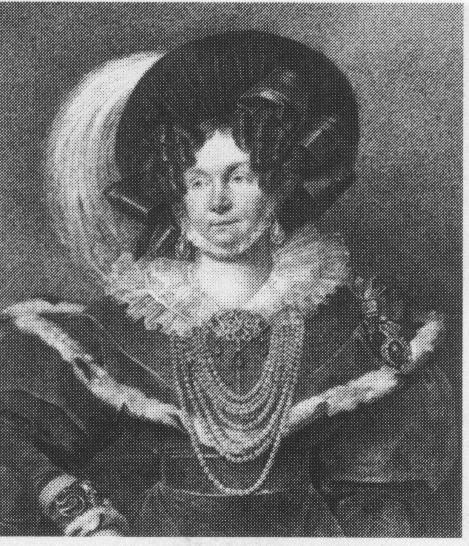<Back to Index>
- Jurist John Austin, 1790
- Writer Karl Anton Postl (Charles Sealsfield), 1793
- Queen Consort of Hanover Frederica of Mecklenburg - Strelitz, 1778
PAGE SPONSOR


Frederica of Mecklenburg - Strelitz (full name: Frederica Louise Caroline Sophie Charlotte Alexandrine) (b. 3 March 1778 – d. 29 June 1841), Duchess of Cumberland and later Queen of Hanover, was the consort of Ernest Augustus I of Hanover, the fifth son and eighth child of George III and Queen Charlotte.
She was born in the Alten Palais of Hanover as the fifth daughter of Charles II, Duke of Mecklenburg - Strelitz and his first wife, Frederica, daughter of George William, Prince of Hesse - Darmstadt. From birth until her first marriage, her title was Her Serene Highness Duchess Frederica of Mecklenburg, Princess of Mecklenburg - Strelitz. Her father assumed the title of Grand Duke of Mecklenburg on 18 June 1815. Duchess Frederica was the niece of her future mother - in - law, Queen Charlotte (formerly Duchess Charlotte of Mecklenburg - Strelitz), since her last husband was her first cousin. Frederica's mother died on 22 May 1782, after giving birth to her tenth child. Two years later (28 September 1784), her father remarried the younger sister of his deceased wife, Charlotte of Hesse - Darmstadt, but this union ended just one year later, when Charlotte died of complications resulting from childbirth, on 12 December 1785. The twice widowed Duke Charles thought he was unable to give his daughters a proper care and education; to this purpose, he sent Frederica and her elder sisters Charlotte, Therese and Louise to their maternal grandmother Maria Louise Albertine of Leiningen - Dagsburg - Falkenburg, Dowager Princess of Hesse - Darmstadt and called Princess George (in allusion to her late husband, the second son of Louis VIII, Landgrave of Hesse - Darmstadt). She was a warm and cheerful person, especially toward Louise and Frederica - the younger sisters -, who felt she was the only mother they really ever knew. The Princess George's choice of a Swiss teacher, Salomé de Gélieu, proved to be a good one. Some time later, Duke Charles also sent his two surviving sons, the Hereditary Prince George and Charles to be raised by their grandmother.
In Frankfurt-am-Main on 14 March 1793, the Princesses of Mecklenburg - Strelitz "coincidentally" met at the Prussian Theatre the Prussian King Frederick William II, who was immediately captivated by the grace and charm of Frederica and her sister Louise. Some weeks later, Frederica and Louise's father began the marriage negotiations with the Prussian King: Louise would marry Crown Prince Frederick William and Frederica would follow suit with his younger brother Frederick Louis Karl (called Prince Louis, b. 5 November 1773). The double engagement was celebrated in Darmstadt on 24 April. On December 24, Louise and the Crown Prince were married in the Royal Palace of Berlin;
two days later, on 26 December Frederica and Prince Louis were also
married in the same place. Unlike her sister, Frederica didn't enjoy a
happy marriage. Her husband preferred the company of his mistresses and
completely neglected her; in response, the humiliated wife apparently
began an affair with her husband's uncle Prince Louis Ferdinand, but these allegations cannot be proved. In 1795 King Frederick William II appointed Louis as Chief of the Dragoons Regiment No. 1, which was stationed in Schwedt, but one year later, on 23 December 1796, he died of diphteria. Frederica and her three children consequently moved to the Schönhausen Palace near Berlin. In 1797 she and her cousin Prince Adolphus, Duke of Cambridge - fifth son of King George III of Great Britain by
his wife Queen Charlotte (Frederica's paternal aunt) - were unofficially
engaged. The Duke of Cambridge asked the consent of his father to the
marriage, but the King, under the pressure of his wife, refused.
In 1798 Frederica became pregnant. The father was Frederick William, Prince of Solms - Braunfels (b.
22 October 1770). The Prince recognized his paternity and asked her
hand in marriage, which was quickly granted in order to avoid the
inevitable scandal. On 10 December of that year, they were married in
Berlin and immediately they moved to Ansbach.
Two months later, in February 1799 Frederica gave birth to a daughter who
only lived eight months. The Prince of Solms - Braunfels, disappointed
and embittered, reasumed his old dissipated lifestyle and became an
alcoholic. In 1805 he resigned from his military posts for "health reasons",
and thus lost his income. Frederica had to maintain her family with her
own resources after her brother-in-law, King Frederick William III of
Prussia, refused to restore her annual pension as a Dowager Princess of
Prussia. Frederica's older brother-in-law and Head of the family,
Prince William Christian Karl of Solms - Braunfels, advised her to get
a
divorce, with his full approval. She and her husband refused. In May 1813, during a visit to his uncle Duke Charles in Neustrelitz, Prince Ernest Augustus, Duke of Cumberland - the fifth son of King George III of Great Britain - met and fell in love with Frederica. Duke
Charles made it clear to his daughter that her separation from the
Prince of Solms - Braunfels was absolutely logical, and that he saw a
marriage with an English prince as a great opportunity for her. During
the next months Frederica thought about the intentions of Ernest
Augustus and the possible effects on her own situation. When, after the
victory of the allies in the Battle of Leipzig,
Ernest Augustus spent some days in Neustrelitz, he was greeted
enthusiastically. Some time later Frederica asked the Prussian King for
approval of her divorce from the Prince of Solms - Braunfels. All parties
agreed, including the Prince of Solms - Braunfels, whose sudden death on
13 April 1814 was considered by some as a little too convenient; some
suspected Frederica had poisoned her husband.
In August the engagement was officially announced. After the British
Parliament gave its consent to the wedding, Frederica and Ernest
Augustus were married on 29 May 1815 at the parish church of Neustrelitz. Some time later, the couple traveled to Great Britain and married again on 29 August 1815 at Carlton House, London. Queen Charlotte bitterly opposed the marriage, even though her future daughter-in-law was also her niece. She
refused to attend the wedding and advised her son to live outside
England with his wife. Frederica never obtained the favor of her
aunt/mother-in-law, who died unreconciled with her in 1818. From her
marriage to Ernest Augustus, she had a further three children, only one
of whom survived childhood: a son, who would eventually become King George V of Hanover. On 20 June 1837 King William IV of the United Kingdom and Hanover died without issue. His heir was Princess Victoria, only daughter of Prince Edward Augustus, Duke of Kent; but because Hanover was ruled under Salic Law since the times of the Holy Roman Empire,
she could not inherit the Hanoverian throne. The next male descendant
of the late King was the Duke of Cumberland, Frederica's husband, who
then became King Ernest Augustus I of Hanover, with Frederica as his
Queen consort. After a short illness, Queen Frederica of Hanover died in 1841 at Hanover. The Court master builder Georg Ludwig Friedrich Laves was instructed by the King to build a mausoleum for his wife and himself in the garden of the Chapel at Schloss Herrenhausen. He also gave royal orders for the transformation of a central square near the Leineschloss and renamed in her honor as Friederikenplatz.